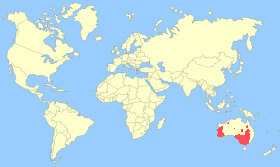Appearance: - The Pink-eared Duck has a grey-brown crown and rear neck, a whitish face with large dark-brown eye patches, brown eyes with white eye ring, a large spatulate light-grey beak, a brown back, the breast, underparts, and flanks are whitish with dark-brown barring, a white rump and brownish-black tail with white tip, brown wings with whitish tips on secondaries, and legs and feet are light-grey. This duck gets its name from a small pink patch behing the eye. Both sexes are alike.
Size: - Typical Adult is 38-40cm (15-16in).
Food: - Plankton, crustaceans, molluscs, and aquatic insects. They use their large beak for filtering small organisms from algae and plankton.
Habitat/Range: - Shallow flood plains, freshwater and brackish lakes and pools throughout Australia. They are highly mobile and will search for appropriate waters.

 Breeding Habitat/Resident,
Breeding Habitat/Resident,  Migration or Winter Area.
Migration or Winter Area.Breeding Season: - Varies considerably depending on available waterways and food.
Eggs: - 6 to 8 (creamy-white colour).
Notes: - The Pink-eared Duck is the only living member of the genus Malacorhynchus. It was formerly thought to be a Perching Duck but may be related to the Shelducks or Stiff-tailed Ducks. It has a large spatula shaped beak but is not related to the Shoveler. In Australia it is sometimes called the Zebra Duck because of the striping on the underparts.
Conservation status (IUCN 3.1):
Least Concern.
Classification: - Family: Anatidae,
Genus: Malacorhynchus.






